PROJ6003: Risk Management Analysis for Corwin Corporation Project
VerifiedAdded on 2022/11/23
|8
|1564
|323
Report
AI Summary
This report provides a comprehensive analysis of risk management within a project context, specifically examining the case of Corwin Corporation. It begins by identifying critical mistakes made during the project's initiation, including a lack of risk acceptance, the selection of an inexperienced project manager, and inadequate project planning. The report then details the risks caused by these mistakes, such as a lack of leadership and expertise, unclear project direction, and insufficient support from other departments. A risk matrix is presented to prioritize these risks. The second part of the report focuses on risk management strategies, proposing methods to mitigate the identified risks. Finally, the report outlines stakeholder reporting requirements, emphasizing the importance of communication and proactive risk management to avoid project failure. The document highlights the importance of proper planning, experienced leadership, and organizational support for successful project execution.
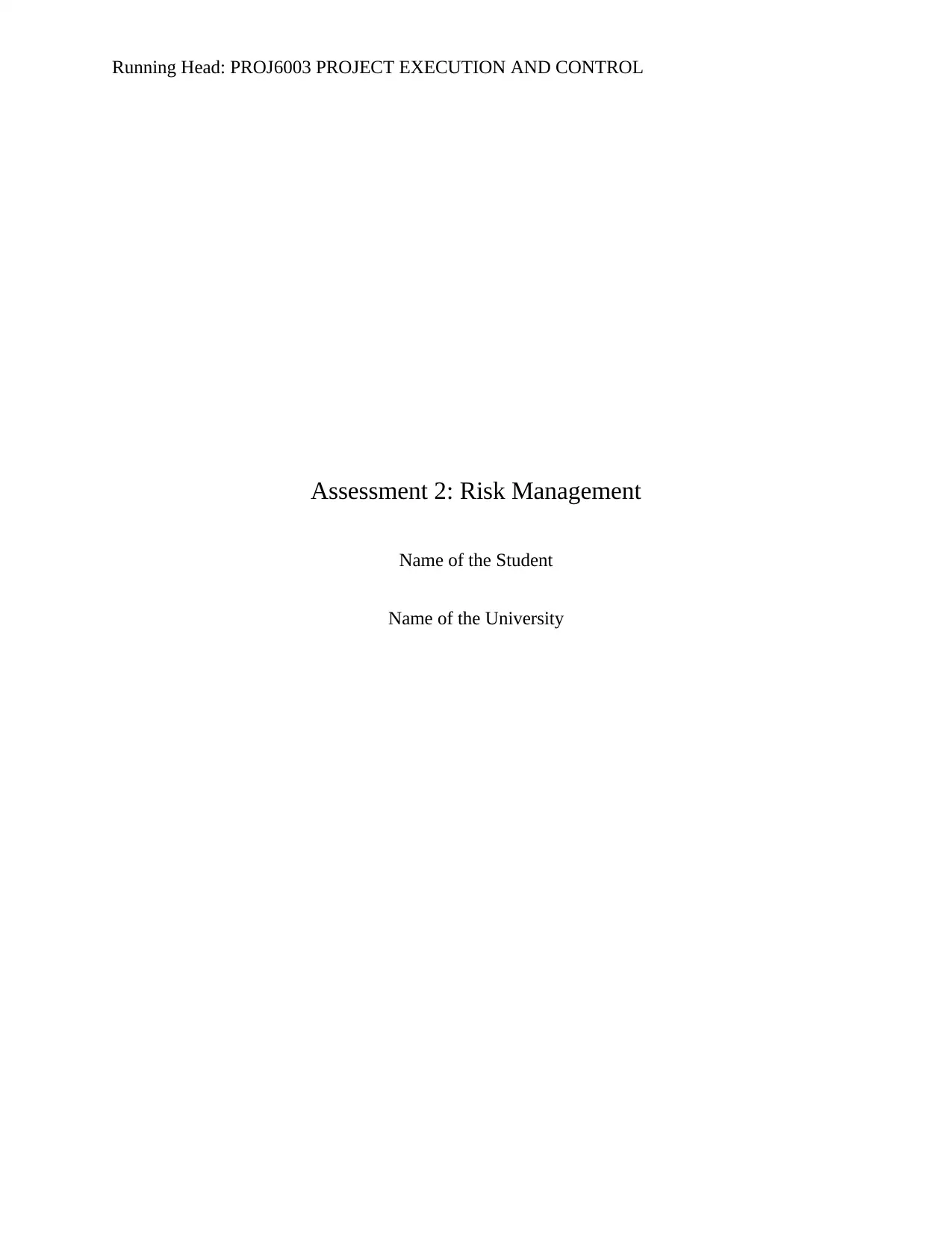
Running Head: PROJ6003 PROJECT EXECUTION AND CONTROL
Assessment 2: Risk Management
Name of the Student
Name of the University
Assessment 2: Risk Management
Name of the Student
Name of the University
Paraphrase This Document
Need a fresh take? Get an instant paraphrase of this document with our AI Paraphraser
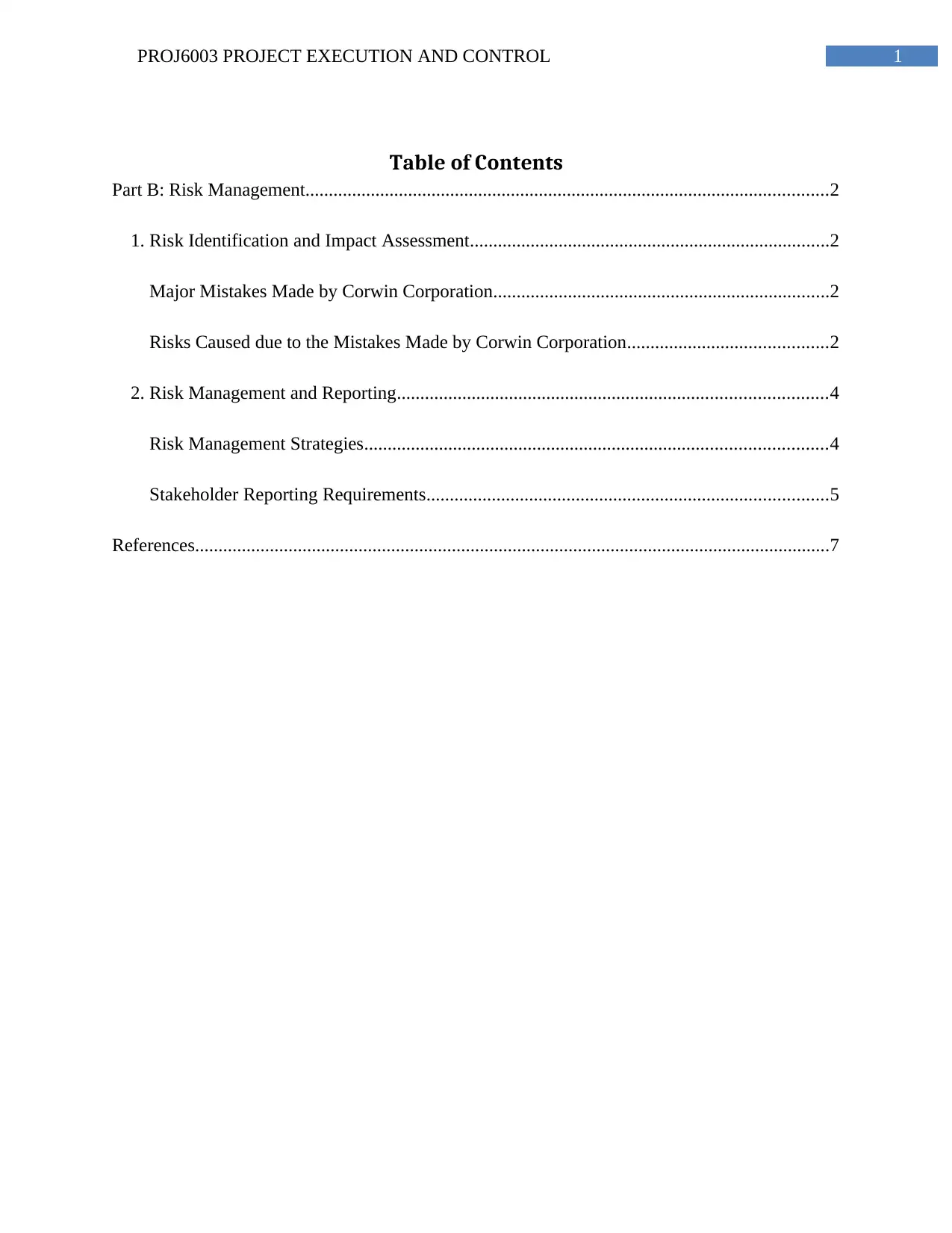
1PROJ6003 PROJECT EXECUTION AND CONTROL
Table of Contents
Part B: Risk Management................................................................................................................2
1. Risk Identification and Impact Assessment.............................................................................2
Major Mistakes Made by Corwin Corporation........................................................................2
Risks Caused due to the Mistakes Made by Corwin Corporation...........................................2
2. Risk Management and Reporting............................................................................................4
Risk Management Strategies...................................................................................................4
Stakeholder Reporting Requirements......................................................................................5
References........................................................................................................................................7
Table of Contents
Part B: Risk Management................................................................................................................2
1. Risk Identification and Impact Assessment.............................................................................2
Major Mistakes Made by Corwin Corporation........................................................................2
Risks Caused due to the Mistakes Made by Corwin Corporation...........................................2
2. Risk Management and Reporting............................................................................................4
Risk Management Strategies...................................................................................................4
Stakeholder Reporting Requirements......................................................................................5
References........................................................................................................................................7
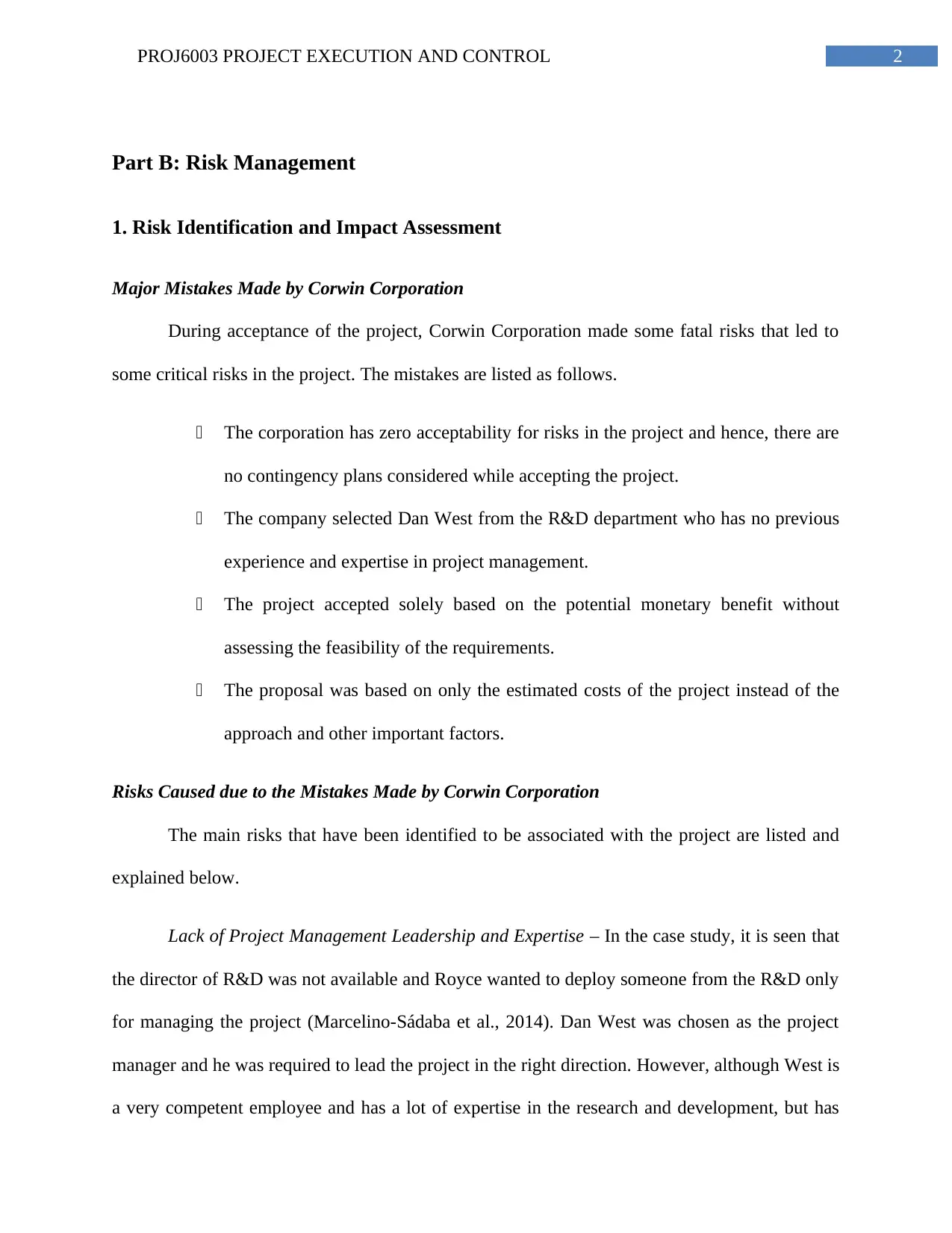
2PROJ6003 PROJECT EXECUTION AND CONTROL
Part B: Risk Management
1. Risk Identification and Impact Assessment
Major Mistakes Made by Corwin Corporation
During acceptance of the project, Corwin Corporation made some fatal risks that led to
some critical risks in the project. The mistakes are listed as follows.
The corporation has zero acceptability for risks in the project and hence, there are
no contingency plans considered while accepting the project.
The company selected Dan West from the R&D department who has no previous
experience and expertise in project management.
The project accepted solely based on the potential monetary benefit without
assessing the feasibility of the requirements.
The proposal was based on only the estimated costs of the project instead of the
approach and other important factors.
Risks Caused due to the Mistakes Made by Corwin Corporation
The main risks that have been identified to be associated with the project are listed and
explained below.
Lack of Project Management Leadership and Expertise – In the case study, it is seen that
the director of R&D was not available and Royce wanted to deploy someone from the R&D only
for managing the project (Marcelino-Sádaba et al., 2014). Dan West was chosen as the project
manager and he was required to lead the project in the right direction. However, although West is
a very competent employee and has a lot of expertise in the research and development, but has
Part B: Risk Management
1. Risk Identification and Impact Assessment
Major Mistakes Made by Corwin Corporation
During acceptance of the project, Corwin Corporation made some fatal risks that led to
some critical risks in the project. The mistakes are listed as follows.
The corporation has zero acceptability for risks in the project and hence, there are
no contingency plans considered while accepting the project.
The company selected Dan West from the R&D department who has no previous
experience and expertise in project management.
The project accepted solely based on the potential monetary benefit without
assessing the feasibility of the requirements.
The proposal was based on only the estimated costs of the project instead of the
approach and other important factors.
Risks Caused due to the Mistakes Made by Corwin Corporation
The main risks that have been identified to be associated with the project are listed and
explained below.
Lack of Project Management Leadership and Expertise – In the case study, it is seen that
the director of R&D was not available and Royce wanted to deploy someone from the R&D only
for managing the project (Marcelino-Sádaba et al., 2014). Dan West was chosen as the project
manager and he was required to lead the project in the right direction. However, although West is
a very competent employee and has a lot of expertise in the research and development, but has
⊘ This is a preview!⊘
Do you want full access?
Subscribe today to unlock all pages.

Trusted by 1+ million students worldwide
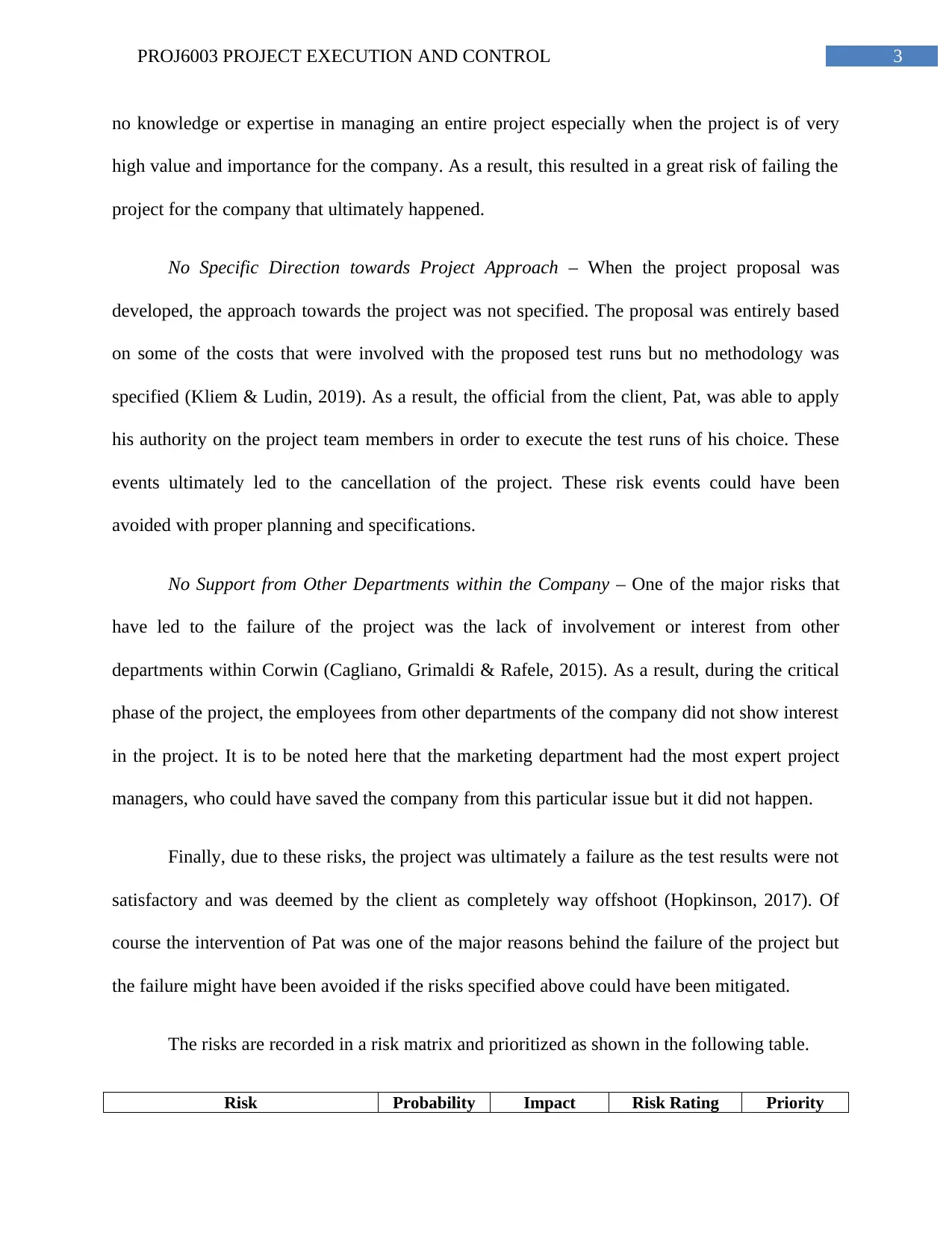
3PROJ6003 PROJECT EXECUTION AND CONTROL
no knowledge or expertise in managing an entire project especially when the project is of very
high value and importance for the company. As a result, this resulted in a great risk of failing the
project for the company that ultimately happened.
No Specific Direction towards Project Approach – When the project proposal was
developed, the approach towards the project was not specified. The proposal was entirely based
on some of the costs that were involved with the proposed test runs but no methodology was
specified (Kliem & Ludin, 2019). As a result, the official from the client, Pat, was able to apply
his authority on the project team members in order to execute the test runs of his choice. These
events ultimately led to the cancellation of the project. These risk events could have been
avoided with proper planning and specifications.
No Support from Other Departments within the Company – One of the major risks that
have led to the failure of the project was the lack of involvement or interest from other
departments within Corwin (Cagliano, Grimaldi & Rafele, 2015). As a result, during the critical
phase of the project, the employees from other departments of the company did not show interest
in the project. It is to be noted here that the marketing department had the most expert project
managers, who could have saved the company from this particular issue but it did not happen.
Finally, due to these risks, the project was ultimately a failure as the test results were not
satisfactory and was deemed by the client as completely way offshoot (Hopkinson, 2017). Of
course the intervention of Pat was one of the major reasons behind the failure of the project but
the failure might have been avoided if the risks specified above could have been mitigated.
The risks are recorded in a risk matrix and prioritized as shown in the following table.
Risk Probability Impact Risk Rating Priority
no knowledge or expertise in managing an entire project especially when the project is of very
high value and importance for the company. As a result, this resulted in a great risk of failing the
project for the company that ultimately happened.
No Specific Direction towards Project Approach – When the project proposal was
developed, the approach towards the project was not specified. The proposal was entirely based
on some of the costs that were involved with the proposed test runs but no methodology was
specified (Kliem & Ludin, 2019). As a result, the official from the client, Pat, was able to apply
his authority on the project team members in order to execute the test runs of his choice. These
events ultimately led to the cancellation of the project. These risk events could have been
avoided with proper planning and specifications.
No Support from Other Departments within the Company – One of the major risks that
have led to the failure of the project was the lack of involvement or interest from other
departments within Corwin (Cagliano, Grimaldi & Rafele, 2015). As a result, during the critical
phase of the project, the employees from other departments of the company did not show interest
in the project. It is to be noted here that the marketing department had the most expert project
managers, who could have saved the company from this particular issue but it did not happen.
Finally, due to these risks, the project was ultimately a failure as the test results were not
satisfactory and was deemed by the client as completely way offshoot (Hopkinson, 2017). Of
course the intervention of Pat was one of the major reasons behind the failure of the project but
the failure might have been avoided if the risks specified above could have been mitigated.
The risks are recorded in a risk matrix and prioritized as shown in the following table.
Risk Probability Impact Risk Rating Priority
Paraphrase This Document
Need a fresh take? Get an instant paraphrase of this document with our AI Paraphraser
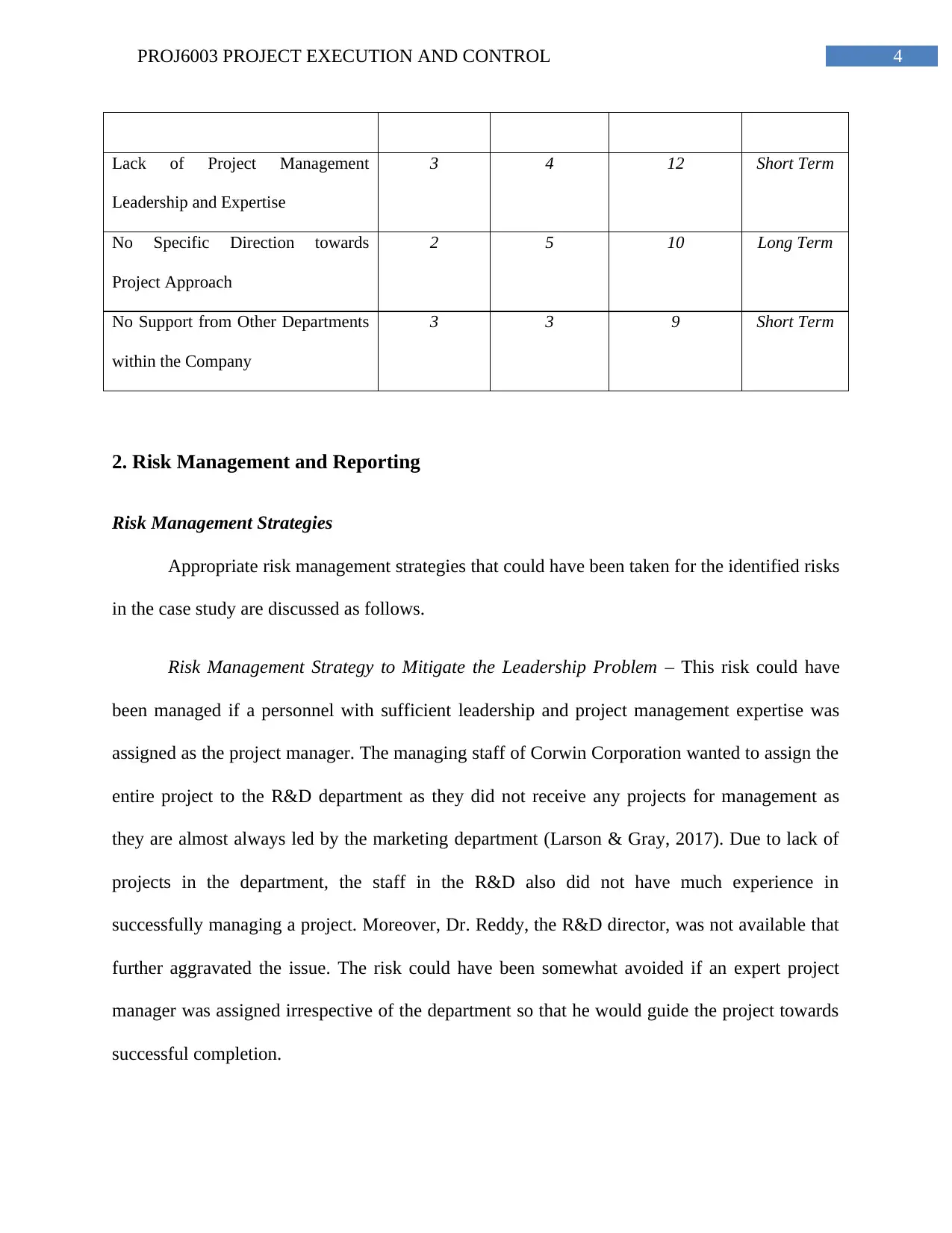
4PROJ6003 PROJECT EXECUTION AND CONTROL
Lack of Project Management
Leadership and Expertise
3 4 12 Short Term
No Specific Direction towards
Project Approach
2 5 10 Long Term
No Support from Other Departments
within the Company
3 3 9 Short Term
2. Risk Management and Reporting
Risk Management Strategies
Appropriate risk management strategies that could have been taken for the identified risks
in the case study are discussed as follows.
Risk Management Strategy to Mitigate the Leadership Problem – This risk could have
been managed if a personnel with sufficient leadership and project management expertise was
assigned as the project manager. The managing staff of Corwin Corporation wanted to assign the
entire project to the R&D department as they did not receive any projects for management as
they are almost always led by the marketing department (Larson & Gray, 2017). Due to lack of
projects in the department, the staff in the R&D also did not have much experience in
successfully managing a project. Moreover, Dr. Reddy, the R&D director, was not available that
further aggravated the issue. The risk could have been somewhat avoided if an expert project
manager was assigned irrespective of the department so that he would guide the project towards
successful completion.
Lack of Project Management
Leadership and Expertise
3 4 12 Short Term
No Specific Direction towards
Project Approach
2 5 10 Long Term
No Support from Other Departments
within the Company
3 3 9 Short Term
2. Risk Management and Reporting
Risk Management Strategies
Appropriate risk management strategies that could have been taken for the identified risks
in the case study are discussed as follows.
Risk Management Strategy to Mitigate the Leadership Problem – This risk could have
been managed if a personnel with sufficient leadership and project management expertise was
assigned as the project manager. The managing staff of Corwin Corporation wanted to assign the
entire project to the R&D department as they did not receive any projects for management as
they are almost always led by the marketing department (Larson & Gray, 2017). Due to lack of
projects in the department, the staff in the R&D also did not have much experience in
successfully managing a project. Moreover, Dr. Reddy, the R&D director, was not available that
further aggravated the issue. The risk could have been somewhat avoided if an expert project
manager was assigned irrespective of the department so that he would guide the project towards
successful completion.
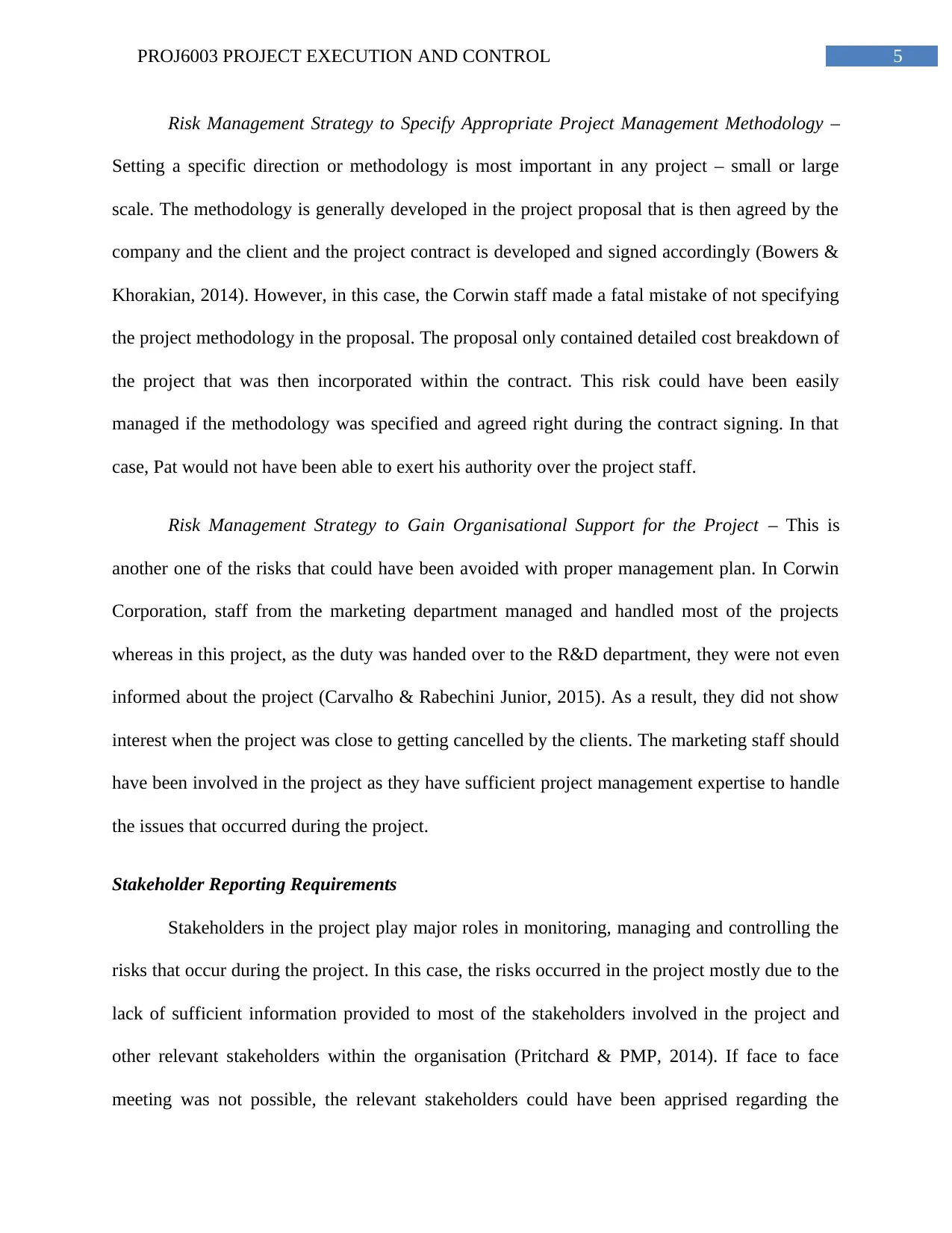
5PROJ6003 PROJECT EXECUTION AND CONTROL
Risk Management Strategy to Specify Appropriate Project Management Methodology –
Setting a specific direction or methodology is most important in any project – small or large
scale. The methodology is generally developed in the project proposal that is then agreed by the
company and the client and the project contract is developed and signed accordingly (Bowers &
Khorakian, 2014). However, in this case, the Corwin staff made a fatal mistake of not specifying
the project methodology in the proposal. The proposal only contained detailed cost breakdown of
the project that was then incorporated within the contract. This risk could have been easily
managed if the methodology was specified and agreed right during the contract signing. In that
case, Pat would not have been able to exert his authority over the project staff.
Risk Management Strategy to Gain Organisational Support for the Project – This is
another one of the risks that could have been avoided with proper management plan. In Corwin
Corporation, staff from the marketing department managed and handled most of the projects
whereas in this project, as the duty was handed over to the R&D department, they were not even
informed about the project (Carvalho & Rabechini Junior, 2015). As a result, they did not show
interest when the project was close to getting cancelled by the clients. The marketing staff should
have been involved in the project as they have sufficient project management expertise to handle
the issues that occurred during the project.
Stakeholder Reporting Requirements
Stakeholders in the project play major roles in monitoring, managing and controlling the
risks that occur during the project. In this case, the risks occurred in the project mostly due to the
lack of sufficient information provided to most of the stakeholders involved in the project and
other relevant stakeholders within the organisation (Pritchard & PMP, 2014). If face to face
meeting was not possible, the relevant stakeholders could have been apprised regarding the
Risk Management Strategy to Specify Appropriate Project Management Methodology –
Setting a specific direction or methodology is most important in any project – small or large
scale. The methodology is generally developed in the project proposal that is then agreed by the
company and the client and the project contract is developed and signed accordingly (Bowers &
Khorakian, 2014). However, in this case, the Corwin staff made a fatal mistake of not specifying
the project methodology in the proposal. The proposal only contained detailed cost breakdown of
the project that was then incorporated within the contract. This risk could have been easily
managed if the methodology was specified and agreed right during the contract signing. In that
case, Pat would not have been able to exert his authority over the project staff.
Risk Management Strategy to Gain Organisational Support for the Project – This is
another one of the risks that could have been avoided with proper management plan. In Corwin
Corporation, staff from the marketing department managed and handled most of the projects
whereas in this project, as the duty was handed over to the R&D department, they were not even
informed about the project (Carvalho & Rabechini Junior, 2015). As a result, they did not show
interest when the project was close to getting cancelled by the clients. The marketing staff should
have been involved in the project as they have sufficient project management expertise to handle
the issues that occurred during the project.
Stakeholder Reporting Requirements
Stakeholders in the project play major roles in monitoring, managing and controlling the
risks that occur during the project. In this case, the risks occurred in the project mostly due to the
lack of sufficient information provided to most of the stakeholders involved in the project and
other relevant stakeholders within the organisation (Pritchard & PMP, 2014). If face to face
meeting was not possible, the relevant stakeholders could have been apprised regarding the
⊘ This is a preview!⊘
Do you want full access?
Subscribe today to unlock all pages.

Trusted by 1+ million students worldwide

6PROJ6003 PROJECT EXECUTION AND CONTROL
project and the risks through written reports (paper document or email), telephone calls or update
reports. Moreover, the stakeholders should have been assigned with specific duties to identify
and manage the risks that might occur during the course of the project.
project and the risks through written reports (paper document or email), telephone calls or update
reports. Moreover, the stakeholders should have been assigned with specific duties to identify
and manage the risks that might occur during the course of the project.
Paraphrase This Document
Need a fresh take? Get an instant paraphrase of this document with our AI Paraphraser
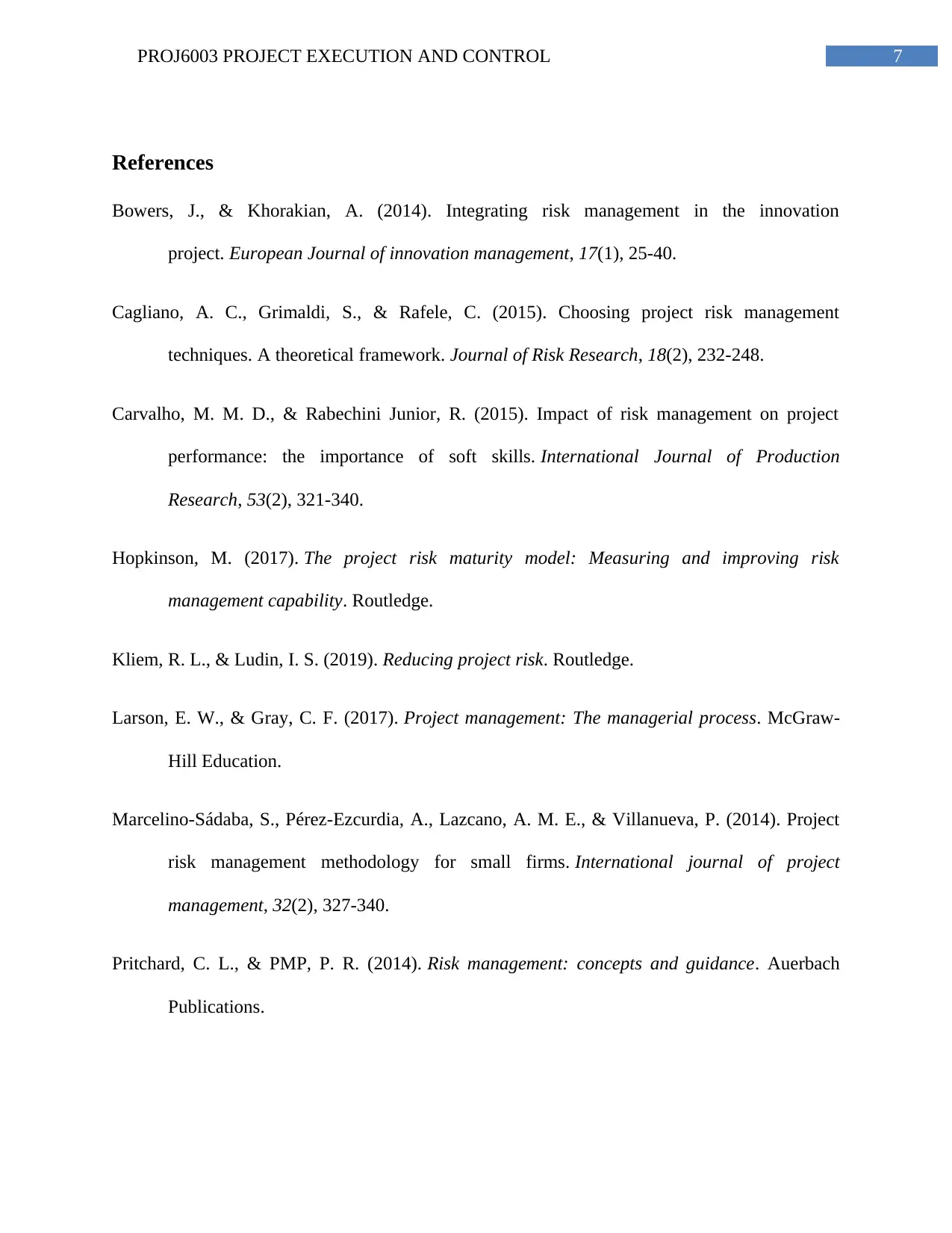
7PROJ6003 PROJECT EXECUTION AND CONTROL
References
Bowers, J., & Khorakian, A. (2014). Integrating risk management in the innovation
project. European Journal of innovation management, 17(1), 25-40.
Cagliano, A. C., Grimaldi, S., & Rafele, C. (2015). Choosing project risk management
techniques. A theoretical framework. Journal of Risk Research, 18(2), 232-248.
Carvalho, M. M. D., & Rabechini Junior, R. (2015). Impact of risk management on project
performance: the importance of soft skills. International Journal of Production
Research, 53(2), 321-340.
Hopkinson, M. (2017). The project risk maturity model: Measuring and improving risk
management capability. Routledge.
Kliem, R. L., & Ludin, I. S. (2019). Reducing project risk. Routledge.
Larson, E. W., & Gray, C. F. (2017). Project management: The managerial process. McGraw-
Hill Education.
Marcelino-Sádaba, S., Pérez-Ezcurdia, A., Lazcano, A. M. E., & Villanueva, P. (2014). Project
risk management methodology for small firms. International journal of project
management, 32(2), 327-340.
Pritchard, C. L., & PMP, P. R. (2014). Risk management: concepts and guidance. Auerbach
Publications.
References
Bowers, J., & Khorakian, A. (2014). Integrating risk management in the innovation
project. European Journal of innovation management, 17(1), 25-40.
Cagliano, A. C., Grimaldi, S., & Rafele, C. (2015). Choosing project risk management
techniques. A theoretical framework. Journal of Risk Research, 18(2), 232-248.
Carvalho, M. M. D., & Rabechini Junior, R. (2015). Impact of risk management on project
performance: the importance of soft skills. International Journal of Production
Research, 53(2), 321-340.
Hopkinson, M. (2017). The project risk maturity model: Measuring and improving risk
management capability. Routledge.
Kliem, R. L., & Ludin, I. S. (2019). Reducing project risk. Routledge.
Larson, E. W., & Gray, C. F. (2017). Project management: The managerial process. McGraw-
Hill Education.
Marcelino-Sádaba, S., Pérez-Ezcurdia, A., Lazcano, A. M. E., & Villanueva, P. (2014). Project
risk management methodology for small firms. International journal of project
management, 32(2), 327-340.
Pritchard, C. L., & PMP, P. R. (2014). Risk management: concepts and guidance. Auerbach
Publications.
1 out of 8
Related Documents
Your All-in-One AI-Powered Toolkit for Academic Success.
+13062052269
info@desklib.com
Available 24*7 on WhatsApp / Email
![[object Object]](/_next/static/media/star-bottom.7253800d.svg)
Unlock your academic potential
Copyright © 2020–2025 A2Z Services. All Rights Reserved. Developed and managed by ZUCOL.




